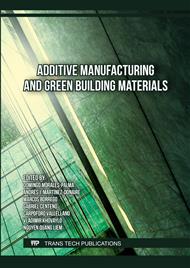[1]
T.D. Ngo, A. Kashani, G. Imbalzano, K.T.Q. Nguyen, D. Hui, Additive manufacturing (3D printing): A review of materials, methods, applications and challenges, Composites Part B: Engineering, 143 (2018).
DOI: 10.1016/j.compositesb.2018.02.012
Google Scholar
[2]
N. Li, S. Huang, G. Zhang, R. Qin, W. Liu, H. Xiong, G. Shi, J. Blackburn, Progress in additive manufacturing on new materials: A review, Journal of Materials Science and Technology, 35 (2019) 242–269.
DOI: 10.1016/j.jmst.2018.09.002
Google Scholar
[3]
I. Gibson, D. Rosen, B. Stucker, Additive manufacturing technologies: 3D printing, rapid prototyping, and direct digital manufacturing, second edition, Additive Manufacturing Technologies: 3D Printing, Rapid Prototyping, and Direct Digital Manufacturing, Second Edition, (2015) 1–498.
DOI: 10.1007/978-1-4939-2113-3
Google Scholar
[4]
J.M. Chacón, M.A. Caminero, E. García-Plaza, P.J. Núñez, Additive manufacturing of PLA structures using fused deposition modelling: Effect of process parameters on mechanical properties and their optimal selection, Materials and Design, 124 (2017) 143–157.
DOI: 10.1016/j.matdes.2017.03.065
Google Scholar
[5]
D. Bilkar, R. Keshavamurthy, V. Tambrallimath, Influence of carbon nanofiber reinforcement on mechanical properties of polymer composites developed by FDM, Materials Today: Proceedings, 46 (2021) 4559–4562.
DOI: 10.1016/j.matpr.2020.09.707
Google Scholar
[6]
M.S. Saharudin, J. Hajnys, T. Kozior, D. Gogolewski, P. Zmarzły, Quality of Surface Texture and Mechanical Properties of PLA and PA-Based Material Reinforced with Carbon Fibers Manufactured by FDM and CFF 3D Printing Technologies, Polymers 2021, Vol. 13, Page 1671, 13 (2021) 1671.
DOI: 10.3390/polym13111671
Google Scholar
[7]
E. García, P.J. Núñez, J.M. Chacón, M.A. Caminero, S. Kamarthi, Comparative study of geometric properties of unreinforced PLA and PLA-Graphene composite materials applied to additive manufacturing using FFF technology, Polymer Testing, 91 (2020) 106860.
DOI: 10.1016/j.polymertesting.2020.106860
Google Scholar
[8]
C.R. Hatz, B. Msallem, S. Aghlmandi, P. Brantner, F.M. Thieringer, Can an entry-level 3D printer create high-quality anatomical models? Accuracy assessment of mandibular models printed by a desktop 3D printer and a professional device, International Journal of Oral and Maxillofacial Surgery, 49 (2020) 143–148.
DOI: 10.1016/j.ijom.2019.03.962
Google Scholar
[9]
D. Singh, R. Singh, K.S. Boparai, Development and surface improvement of FDM pattern based investment casting of biomedical implants: A state of art review, Journal of Manufacturing Processes, 31 (2018) 80–95.
DOI: 10.1016/j.jmapro.2017.10.026
Google Scholar
[10]
J. Luo, Q. Luo, G. Zhang, Q. Li, G. Sun, On strain rate and temperature dependent mechanical properties and constitutive models for additively manufactured polylactic acid (PLA) materials, Thin-Walled Structures, 179 (2022) 109624.
DOI: 10.1016/j.tws.2022.109624
Google Scholar
[11]
R. Teharia, R.M. Singari, H. Kumar, Optimization of process variables for additive manufactured PLA based tensile specimen using taguchi design and artificial neural network (ANN) technique, Materials Today: Proceedings, 56 (2022) 3426–3432.
DOI: 10.1016/j.matpr.2021.10.376
Google Scholar
[12]
L. Marșavina, C. Vălean, M. Mărghitaș, E. Linul, S.M.J. Razavi, F. Berto, R. Brighenti, Effect of the manufacturing parameters on the tensile and fracture properties of FDM 3D-printed PLA specimens, Engineering Fracture Mechanics, 274 (2022) 108766.
DOI: 10.1016/j.engfracmech.2022.108766
Google Scholar
[13]
M. Subramaniyan, S. Karuppan, P. P, P. Anand A, P. Vasanthan A, Survey on compression property of sandwich 3D printed PLA components, Materials Today: Proceedings, 66 (2022) 955–961.
DOI: 10.1016/j.matpr.2022.04.749
Google Scholar
[14]
M. Azadi, A. Dadashi, S. Dezianian, M. Kianifar, S. Torkaman, M. Chiyani, High-cycle bending fatigue properties of additive-manufactured ABS and PLA polymers fabricated by fused deposition modeling 3D-printing, Forces in Mechanics, 3 (2021) 100016.
DOI: 10.1016/j.finmec.2021.100016
Google Scholar
[15]
O.H. Ezeh, L. Susmel, Fatigue strength of additively manufactured polylactide (PLA): effect of raster angle and non-zero mean stresses, International Journal of Fatigue, 126 (2019) 319–326.
DOI: 10.1016/j.ijfatigue.2019.05.014
Google Scholar
[16]
A. García Montesinos, C. Bermudo Gamboa, S. Martín Béjar, L. Sevilla Hurtado, Influence od layer thickness on the fatigue lofe of PLA + Carbon Fiber specimens by additive manufacturing, in: 31 Int. Conf. INGEGRAF. B. Ext. Abstr., Universidad de Málaga, 2022: p.58, 59.
DOI: 10.1007/978-3-031-20325-1_31
Google Scholar
[17]
ISO, ISO 1143:2010 Standard Metallic materials — Rotating bar bending fatigue testing, in: ISO, 2010.
Google Scholar
[18]
G. Gomez-Gras, R. Jerez-Mesa, J.A. Travieso-Rodriguez, J. Lluma-Fuentes, Fatigue performance of fused filament fabrication PLA specimens, Materials & Design, 140 (2018) 278–285.
DOI: 10.1016/j.matdes.2017.11.072
Google Scholar
[19]
M.F. Afrose, S.H. Masood, P. Iovenitti, M. Nikzad, I. Sbarski, Effects of part build orientations on fatigue behaviour of FDM-processed PLA material, Progress in Additive Manufacturing 2015 1:1, 1 (2015) 21–28.
DOI: 10.1007/s40964-015-0002-3
Google Scholar



